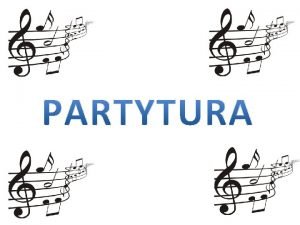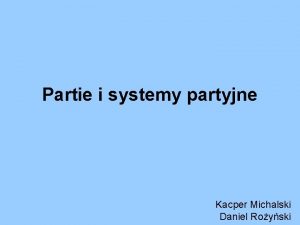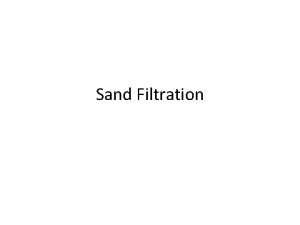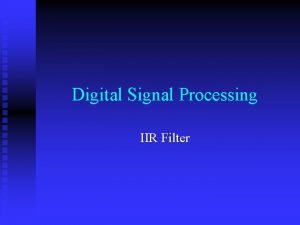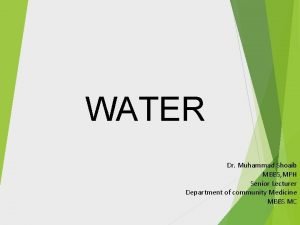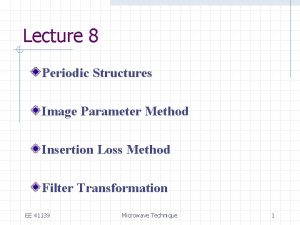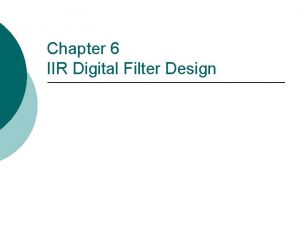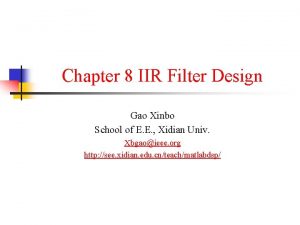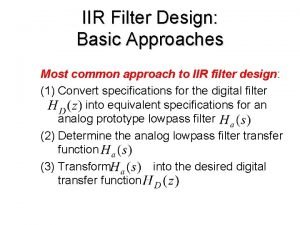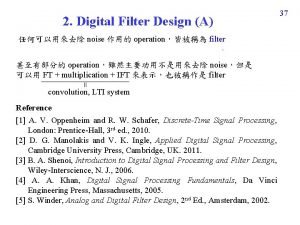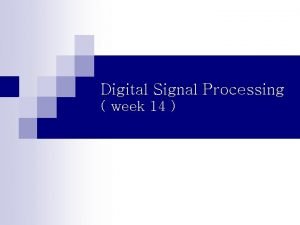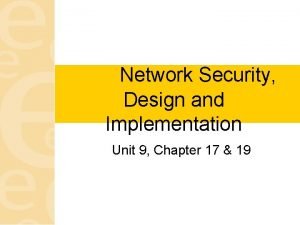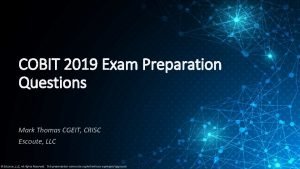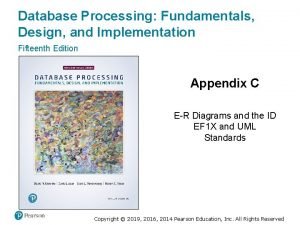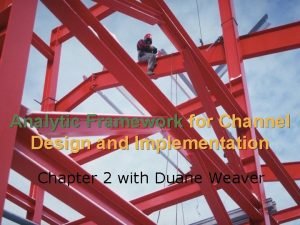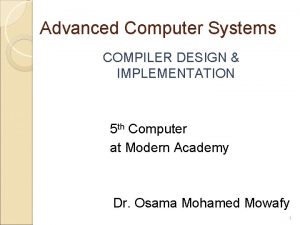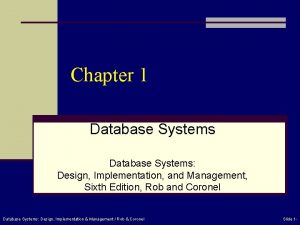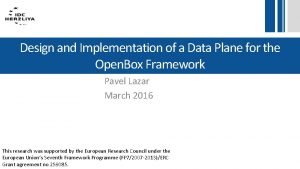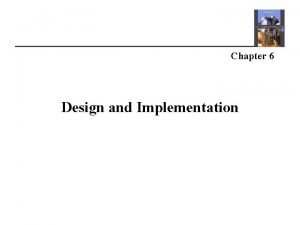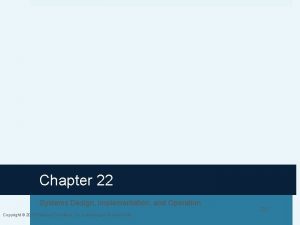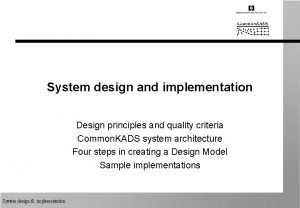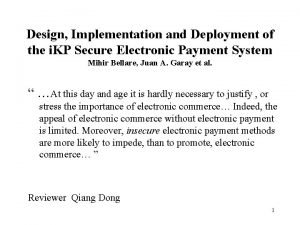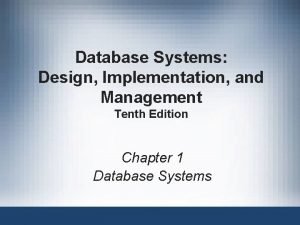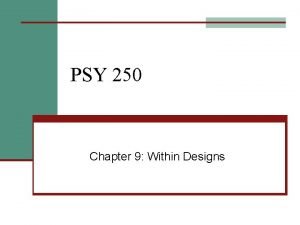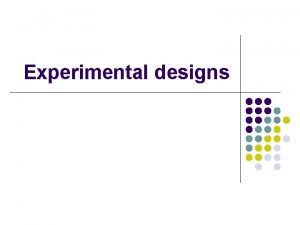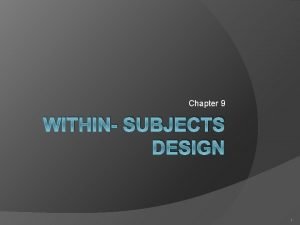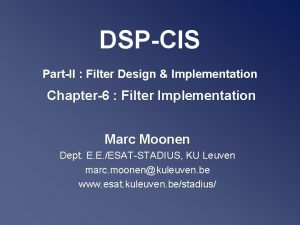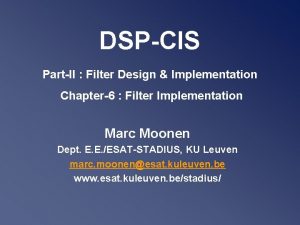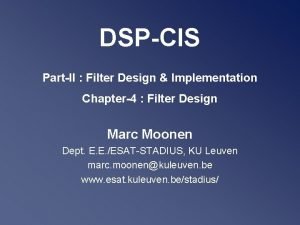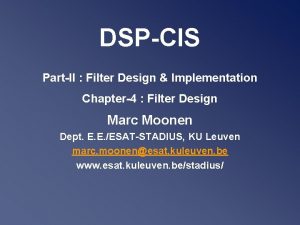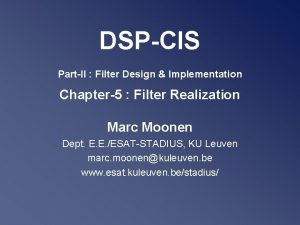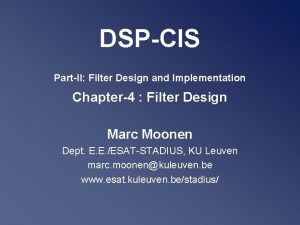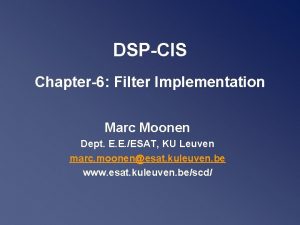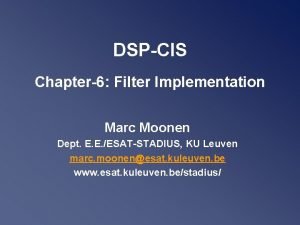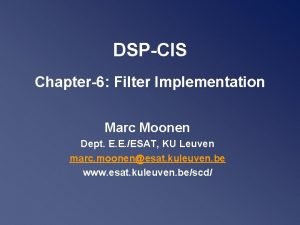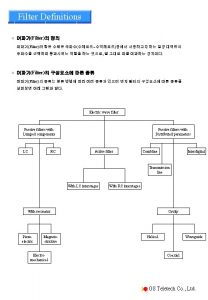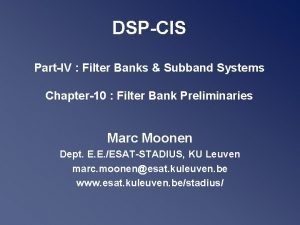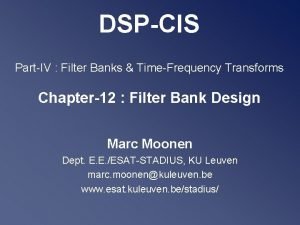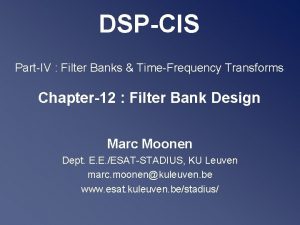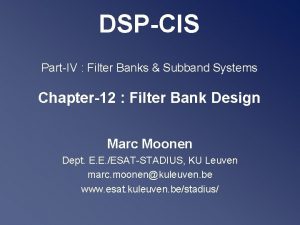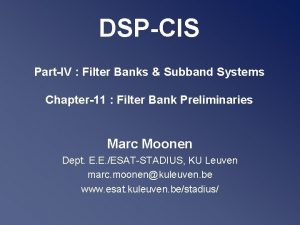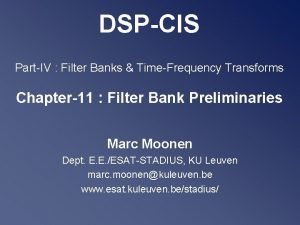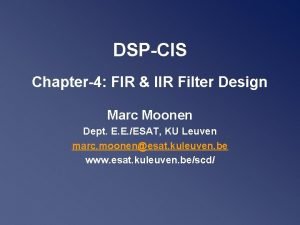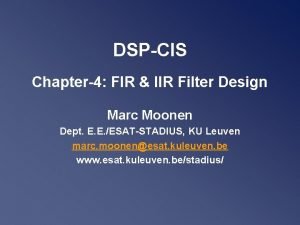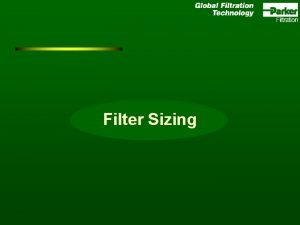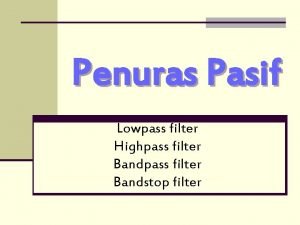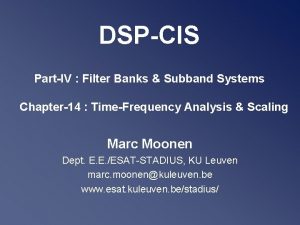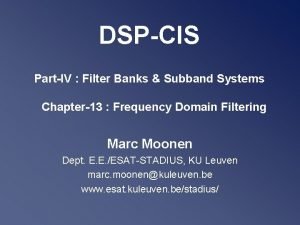DSPCIS PartII Filter Design Implementation Chapter6 Filter Implementation


























![Quantization Noise / Limit Cycles Example: y[k] = -0. 625. y[k-1]+u[k] 4 -bit truncation Quantization Noise / Limit Cycles Example: y[k] = -0. 625. y[k-1]+u[k] 4 -bit truncation](https://slidetodoc.com/presentation_image_h/82dc58a49b3cf6426e767a8d813d4f65/image-27.jpg)






![Scaling e d i u[k] • Example: s i h l s • assume Scaling e d i u[k] • Example: s i h l s • assume](https://slidetodoc.com/presentation_image_h/82dc58a49b3cf6426e767a8d813d4f65/image-34.jpg)






- Slides: 40

DSP-CIS Part-II : Filter Design & Implementation Chapter-6 : Filter Implementation Marc Moonen Dept. E. E. /ESAT-STADIUS, KU Leuven marc. moonen@kuleuven. be www. esat. kuleuven. be/stadius/

Filter Design Process • Step-1 : Define filter specs Pass-band, stop-band, optimization criterion, … • Step-2 : Derive optimal transfer function FIR or IIR design Chapter-4 • Step-3 : Filter realization (block scheme/flow graph) Direct form realizations, lattice realizations, … Chapter-5 • Step-4 : Filter implementation (software/hardware) Finite word-length issues, … Chapter-6 Question: implemented filter = designed filter ? ‘You can’t always get what you want’ -Jagger/Richards (? ) DSP-CIS 2017 / Part-II / Chapter-6: Filter Implementation 2 / 40

Chapter-6 : Filter Implementation • Introduction Filter implementation & finite wordlength problem • Coefficient Quantization • Arithmetic Operations Quantization noise Statistical Analysis Limit Cycles Scaling • PS: Short version, does not include… Fixed & floating point representations, overflow, etc. (see literature) DSP-CIS 2017 / Part-II / Chapter-6: Filter Implementation 3 / 40

Introduction Back to Chapter-5… Q: Why bother about many different realizations for one and the same filter? DSP-CIS 2017 / Part-II / Chapter-6: Filter Implementation 4 / 40

Introduction Filter implementation/finite word-length problem • So far have assumed that signals/coefficients/arithmetic operations are represented/performed with infinite precision • In practice, numbers can be represented only to a finite precision, and hence signals/coefficients/arithmetic operations are subject to quantization (truncation/rounding/. . . ) errors • Investigate impact of… - quantization of filter coefficients - quantization in arithmetic operations DSP-CIS 2017 / Part-II / Chapter-6: Filter Implementation 5 / 40

Introduction Filter implementation/finite word-length problem • We consider fixed-point filter implementations, with a `short’ word-length In hardware design, with tight speed requirements, finite word-length problem is a relevant problem • In signal processors with a `sufficiently long‘ word-length, e. g. with 24 bits (=7 decimal digits) precision, or with floating -point representations and arithmetic, finite word-length issues are less relevant DSP-CIS 2017 / Part-II / Chapter-6: Filter Implementation 6 / 40

Introduction: Example • • • % IIR Elliptic Lowpass filter designed using % ELLIP function. % All frequency values are in Hz. Fs = 48000; % Sampling Frequency L = 8; % Order Fpass = 9600; % Passband Frequency Apass = 60; % Passband Ripple (d. B) Astop = 160; % Stopband Attenuation (d. B) Transfer function Poles & zeros DSP-CIS 2017 / Part-II / Chapter-6: Filter Implementation 7 / 40

Introduction: Example Filter outputs… Direct form realization @ infinite precision… Lattice-ladder realization @ infinite precision… Difference… DSP-CIS 2017 / Part-II / Chapter-6: Filter Implementation 8 / 40

Introduction: Example Filter outputs… Direct form realization @ infinite precision… Direct form realization @ 8 -bit precision… Difference… DSP-CIS 2017 / Part-II / Chapter-6: Filter Implementation 9 / 40

Introduction: Example Filter outputs… Direct form realization @ infinite precision… Lattice-ladder realization @ 8 -bit precision… Difference… Better select a good realization ! DSP-CIS 2017 / Part-II / Chapter-6: Filter Implementation 10 / 40

Coefficient Quantization Coefficient quantization problem • Filter design in Matlab (e. g. ) provides filter coefficients to 15 decimal digits (such that filter meets specifications) • For implementation, have to quantize coefficients to the word-length used for the implementation • As a result, implemented filter may fail to meet specifications… DSP-CIS 2017 / Part-II / Chapter-6: Filter Implementation 11 / 40

Example from Better select a good realization ! DSP-CIS 2017 / Part-II / Chapter-6: Filter Implementation 12 / 40

Coefficient Quantization Coefficient quantization effect on pole locations • Example : 2 nd-order system (e. g. for cascade/direct form realization) `Triangle of stability’ : denominator polynomial is stable (i. e. roots inside unit circle) iff coefficients lie inside triangle… 1 -2 2 -1 Proof: Apply Schur-Cohn stability test (see Chapter-5). DSP-CIS 2017 / Part-II / Chapter-6: Filter Implementation 13 / 40

Coefficient Quantization • Example (continued) With 5 bits per coefficient, all possible `quantized’ pole positions are. . . Low density of `quantized’ pole locations at z=1, z=-1, hence problem for narrow-band LP and HP filters in (transposed) direct form (see Chapter-4). DSP-CIS 2017 / Part-II / Chapter-6: Filter Implementation 14 / 40

Coefficient Quantization • Example (continued) Possible remedy: `coupled realization’ Poles are where are realized/quantized hence ‘quantized’ pole locations are (5 bits) u[k] + + + y[k] coefficient precision = pole precision DSP-CIS 2017 / Part-II / Chapter-6: Filter Implementation 15 / 40

Coefficient Quantization Coefficient quantization effect on pole locations • Higher-order systems (first-order analysis) Tightly spaced poles (e. g. for narrow band filters) imply high sensitivity of pole locations to coefficient quantization Hence preference for low-order systems (e. g. in parallel/cascade) DSP-CIS 2017 / Part-II / Chapter-6: Filter Implementation 16 / 40

Coefficient Quantization Coefficient quantization effect on zero locations • Analog filter design + bilinear transformation often lead to numerator polynomial of the form (e. g. 2 nd-order cascade realization) hence with zeros always on the unit circle Quantization of the coefficient shifts zeros on the unit circle, which mostly has only minor effect on the filter characteristic. Hence mostly ignored… DSP-CIS 2017 / Part-II / Chapter-6: Filter Implementation 17 / 40

Coefficient Quantization Coefficient quantization in lossless lattice realizations o = original transfer function + = transfer function after 8 -bit truncation of lossless lattice filter coefficients - = transfer function after 8 -bit truncation of direct-form coefficients (bi’s) In lossless lattice, all coefficients are sines and cosines, hence all values between – 1 and +1…, i. e. `dynamic range’ and coefficient quantization error well under control. DSP-CIS 2017 / Part-II / Chapter-6: Filter Implementation 18 / 40

Arithmetic Operations Quantization noise problem • If two B-bit numbers are added, the result is a B+1 bit number. • If two B-bit numbers are multiplied, the result is a 2 B-1 bit number. • Typically (especially so in an IIR (feedback) filter), the result of an addition/multiplication has to be represented again as a B’-bit number (e. g. B’=B). Hence have to remove least significant bits (*). • Rounding/truncation/… to B’ bits introduces quantization noise. • The effect of quantization noise is usually analyzed in a statistical manner (see p. 20 -25) • Quantization, however, is a deterministic non-linear effect, which may give rise to limit cycle oscillations (see p. 26 -30) (*). . and/or most significant bits - not considered here DSP-CIS 2017 / Part-II / Chapter-6: Filter Implementation 19 / 40

Quantization Noise / Statistical Analysis Quantization mechanisms Rounding Truncation Magnitude Truncation output input probability error mean=0 mean=(-0. 5)LSB (biased!) mean=0 variance=(1/12)LSB^2 variance=(1/6)LSB^2 PS: …assuming input to quantization is uniformly distributed (is it? ) DSP-CIS 2017 / Part-II / Chapter-6: Filter Implementation 20 / 40

Quantization Noise / Statistical Analysis Statistical analysis is based on the following assumptions : - Each quantization error is random, i. e. uncorrelated/independent of the number that is quantized, and with uniform probability distribution function (see previous slide) (ps: model more suited for multipliers than for adders) - Successive quantization errors at the output of a given multiplier/adder are uncorrelated/independent (=white noise assumption) - Quantization errors at the outputs of different multipliers/adders are uncorrelated/independent (=independent sources assumption) u[k] + One noise source is inserted after each multiplier/adder e 2[k] + Since the filter is a linear filter the output noise generated by each noise source is added to the output signal y[k] DSP-CIS 2017 / Part-II / Chapter-6: Filter Implementation + -. 99 e 1[k] x 21 / 40

Quantization Noise / Statistical Analysis Effect on the output signal of a noise generated at a particular point in the filter is computed as follows: - Noise is e[k], assumed white (=flat PSD) with mean & variance - Transfer function from e[k] to filter output is G(z), g[k] (=‘noise transfer function’) - Noise mean at the output is - Noise variance at the output is Repeat procedure for each noise source… DSP-CIS 2017 / Part-II / Chapter-6: Filter Implementation 22 / 40

Quantization Noise / Statistical Analysis PS: In a transposed direct form realization all noise transfer functions are equal (up to delay), hence all noise sources can be lumped into one equivalent noise source u[k] bo b 1 x x x 1[k] e[k] …which simplifies analysis considerably + b 2 x x 2[k] + b 3 x x 3[k] + b 4 x x 4[k] + -a 1 -a 2 -a 3 -a 4 x x y[k] DSP-CIS 2017 / Part-II / Chapter-6: Filter Implementation 23 / 40

Quantization Noise / Statistical Analysis PS: In a direct form realization all noise sources can be lumped into two equivalent noise sources e 1[k] u[k] + + -a 1 -a 2 -a 3 -a 4 x x x 1[k] …which simplifies analysis considerably x 3[k] x 4[k] bo b 1 b 2 b 3 b 4 x x x y[k] DSP-CIS 2017 / Part-II / Chapter-6: Filter Implementation x 2[k] + + e 2[k] + + 24 / 40

Quantization Noise / Statistical Analysis PS: Quantization noise of A/D-converters can be modeled/analyzed in a similar fashion. Noise transfer function is filter transfer function H(z) PS: Quantization noise of D/A-converters can be modeled/analyzed in a similar fashion. Non-zero quantization noise if D/A converter wordlength is shorter than filter wordlength. Noise transfer function = 1 DSP-CIS 2017 / Part-II / Chapter-6: Filter Implementation 25 / 40

Quantization Noise / Limit Cycles Statistical analysis is simple/convenient, but quantization is truly a non-linear effect, and should be analyzed as a deterministic process Though very difficult, such analysis may reveal odd behavior : Example: y[k] = -0. 625. y[k-1]+u[k] 4 -bit rounding arithmetic input u[k]=0, y[0]=3/8 output y[k] = 3/8, -1/4, 1/8, -1/8, . . Oscillations in the absence of input (u[k]=0) are called `zero-input limit cycle oscillations’ DSP-CIS 2017 / Part-II / Chapter-6: Filter Implementation 26 / 40
![Quantization Noise Limit Cycles Example yk 0 625 yk1uk 4 bit truncation Quantization Noise / Limit Cycles Example: y[k] = -0. 625. y[k-1]+u[k] 4 -bit truncation](https://slidetodoc.com/presentation_image_h/82dc58a49b3cf6426e767a8d813d4f65/image-27.jpg)
Quantization Noise / Limit Cycles Example: y[k] = -0. 625. y[k-1]+u[k] 4 -bit truncation (instead of rounding) input u[k]=0, y[0]=3/8 output y[k] = 3/8, -1/4, 1/8, 0, 0, 0, . . (no limit cycle!) Example: y[k] = 0. 625. y[k-1]+u[k] 4 -bit rounding input u[k]=0, y[0]=3/8 output y[k] = 3/8, 1/4, 1/8, . . Example: y[k] = 0. 625. y[k-1]+u[k] 4 -bit truncation input u[k]=0, y[0]=-3/8 output y[k] = -3/8, -1/4, -1/8, . . Conclusion: weird, … ! DSP-CIS 2017 / Part-II / Chapter-6: Filter Implementation 27 / 40

Quantization Noise / Limit Cycles • Limit cycle oscillations are clearly unwanted (e. g. may be audible in speech/audio applications) • Limit cycle oscillations can only appear if the filter has feedback. Hence FIR filters cannot have limit cycle oscillations • Mathematical analysis is very difficult DSP-CIS 2017 / Part-II / Chapter-6: Filter Implementation 28 / 40

Quantization Noise / Limit Cycles • Truncation often helps to avoid limit cycles (e. g. magnitude truncation, where absolute value of quantizer output is never larger than absolute value of quantizer input (=`passive quantizer’)) • Some filter realizations can be made limit cycle free, e. g. coupled realization, orthogonal filters (details omitted) DSP-CIS 2017 / Part-II / Chapter-6: Filter Implementation 29 / 40

Quantization Noise / Limit Cycles Here’s the good news: For a. . • lossless lattice realization of a general IIR filter • lattice-ladder realization of a general IIR filter …when magnitude truncation (=`passive quantization’) is used, the filter is guaranteed to be free of limit cycles ! (details omitted) Intuition: quantization consumes energy/power, orthogonal filter operations do not generate power to feed limit cycle DSP-CIS 2017 / Part-II / Chapter-6: Filter Implementation 30 / 40

Scaling The scaling problem e d i l s • Finite word-length implementation implies maximum representable number. Whenever a signal (output or internal) exceeds this value, overflow occurs. • Digital overflow may lead (e. g. in 2’s-complement arithmetic) to polarity reversal (instead of saturation such as in analog circuits), hence may be very harmful. • Avoid overflow through proper signal scaling, implemented by bit shiftoperations applied to signals, or by scaling of filter coefficients, or. . • Scaled transfer function may be c. H(z) instead of H(z) (hence need proper tracing of scaling factors) i k S s i h t p DSP-CIS 2017 / Part-II / Chapter-6: Filter Implementation 31 / 40

Scaling Time domain (‘deterministic’) scaling: e d i l s • Assume input signal is bounded in magnitude s i h i. e. u-max is the largest number that can be represented in the `words’ reserved for the input signal t p • Then output signal is bounded by i k S ps : stability of the filter h implies that its 1 -norm is finite DSP-CIS 2017 / Part-II / Chapter-6: Filter Implementation 32 / 40

Scaling e d i Time domain (‘deterministic’) scaling: (continued) • Assume input signal is bounded in magnitude s i h • Then output signal is bounded by i k • To satisfy S l s t p i. e. y-max is the largest number that can be represented in the `words’ reserved for the output signal we have to scale H(z) to c. H(z), with DSP-CIS 2017 / Part-II / Chapter-6: Filter Implementation 33 / 40
![Scaling e d i uk Example s i h l s assume Scaling e d i u[k] • Example: s i h l s • assume](https://slidetodoc.com/presentation_image_h/82dc58a49b3cf6426e767a8d813d4f65/image-34.jpg)
Scaling e d i u[k] • Example: s i h l s • assume u[k] produced by 12 -bit A/D-converter • assume we use 16 -bit arithmetic for y[k] & multiplier i k S t p u[k] 0. 99 DSP-CIS 2017 / Part-II / Chapter-6: Filter Implementation x y[k] shift + 0. 99 x • hence inputs u[k] have to be shifted by 3 bits to the right before entering the filter (=remove 3 LSB’s) + y[k] 34 / 40

Scaling Time domain (‘deterministic’) scaling: l s Frequency domain (‘deterministic’) scaling: s i h e d i • Frequency-domain analysis leads to alternative scaling factors, e. g. . . or. . . S i k t p …which may (or may not) be less conservative -> proper choice of scaling factor in general is a difficult problem DSP-CIS 2017 / Part-II / Chapter-6: Filter Implementation 35 / 40

Scaling e d i L 2 -scaling: (`scaling in L 2 sense’, `probabilistic scaling’) l s • Time-domain scaling is simple & guarantees that overflow will never occur, but often over-conservative (=too small c) • Define L 2 -norm : s i h • If input signal u[k] is (`wide sense’) stationary signal with power spectral density (`PSD’, i. e. Fourier transform of its covariance sequence) then variance of output signal y[k] is bounded: i k S t p • Leads to scaling factor where alpha defines overflow probability DSP-CIS 2017 / Part-II / Chapter-6: Filter Implementation 36 / 40

Scaling e d i • So far considered scaling of H(z), i. e. transfer function from u[k] to y[k]. • In practice, have to consider overflow and scaling of each internal signal, i. e. scaling + + of transfer function from u[k] to each and every internal signal ! -a 1 -a 2 -a 3 -a 4 x x May require quite some thinking… x 1[k] x 2[k] x 3[k] x 4[k] (but doable) i k S l s s i h t p DSP-CIS 2017 / Part-II / Chapter-6: Filter Implementation bo b 1 b 2 b 3 b 4 x x x y[k] + + 37 / 40

Scaling e d i • Something that may help: If 2’s-complement arithmetic is used, and if the sum of K numbers (K>2) is guaranteed not to overflow, then overflows in partial sums cancel out and do not affect the final result (similar to `modulo arithmetic’) + + • Example: s i h if x 1+x 2+x 3+x 4 is guaranteed not to overflow, then if in (((x 1+x 2)+x 3)+x 4) the sum (x 1+x 2) overflows, this overflow can be ignored, without affecting the final result. • As a result (1), in a direct form realization, only 2 signals have to be considered in view of scaling : i k S t p DSP-CIS 2017 / Part-II / Chapter-6: Filter Implementation l s -a 1 -a 2 -a 3 -a 4 x x x 1[k] x 2[k] x 3[k] x 4[k] bo b 1 b 2 b 3 b 4 x x x + + 38 / 40

Scaling e d i • As a result (2), in a transposed direct form realization, only 1 signal has to be considered in view of scaling: l s u[k] i k S s i h t p DSP-CIS 2017 / Part-II / Chapter-6: Filter Implementation bo b 1 b 2 b 3 b 4 x x x 1[k] + x 2[k] + x 3[k] x 4[k] + + -a 1 -a 2 -a 3 -a 4 x x y[k] 39 / 40

Scaling • As a result (3), in a state space realization only output signal + internal states have to be considered in view of scaling: u[k] s i h -Matrix l s e d i + + y[k] t p defines transfer from input to internal states ( i-th row has impulse response from input u[k] to i-th internal state) -Internal states can be re-scaled by means of diagonal transformation T, such that i k S -If T is such that all rows of this tilde-matrix have equal L 2 -norm, then overflow probability is the same in all states. This is referred to as ‘L 2 scaled realization’ DSP-CIS 2017 / Part-II / Chapter-6: Filter Implementation 40 / 40
 Klaudia kulpa
Klaudia kulpa Funkcje partii politycznych
Funkcje partii politycznych Perbedaan rapid sand filter dan slow sand filter
Perbedaan rapid sand filter dan slow sand filter Blt method will convert analog filter to dt filter that has
Blt method will convert analog filter to dt filter that has Difference between rapid sand filter and slow sand filter
Difference between rapid sand filter and slow sand filter Image parameter method
Image parameter method Impulse invariant method iir filter design
Impulse invariant method iir filter design Webench filter design
Webench filter design Trickling filter design calculations
Trickling filter design calculations Bakki shower filter design
Bakki shower filter design Filterpro ti
Filterpro ti Cutoff frequency formula
Cutoff frequency formula Iir filter design matlab
Iir filter design matlab Design a butterworth filter
Design a butterworth filter Digital filter design
Digital filter design Constant rate filtration example
Constant rate filtration example Digital filter design
Digital filter design Network security design and implementation
Network security design and implementation Uiecu
Uiecu Cobit 2019 design and implementation exam questions
Cobit 2019 design and implementation exam questions Accessible learning experience design and implementation
Accessible learning experience design and implementation Intune deployment planning, design and implementation guide
Intune deployment planning, design and implementation guide Database processing 15th edition
Database processing 15th edition Channel design and implementation
Channel design and implementation Advanced compiler design and implementation
Advanced compiler design and implementation Database system design implementation and management
Database system design implementation and management Symmetric shared memory architecture
Symmetric shared memory architecture Obiarchitecture
Obiarchitecture Implementation in software engineering
Implementation in software engineering System design implementation and operation
System design implementation and operation Implementation design principles
Implementation design principles I kp
I kp Database systems 10th edition
Database systems 10th edition Vcaa technical drawing specifications
Vcaa technical drawing specifications Design input vs design output
Design input vs design output Types of design
Types of design What is decorative design
What is decorative design Counterbalancing
Counterbalancing Process design and control design should always be in
Process design and control design should always be in Within-subjects design
Within-subjects design Within subjects vs between subjects
Within subjects vs between subjects
